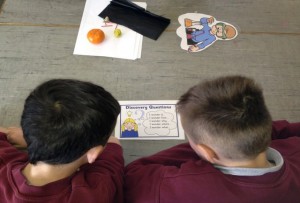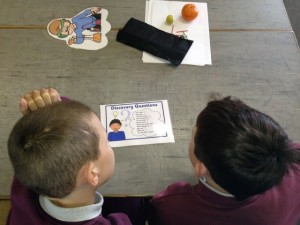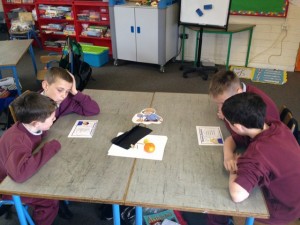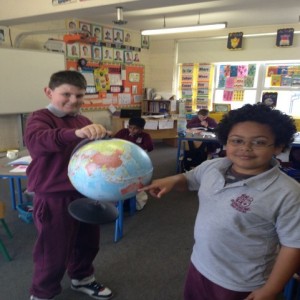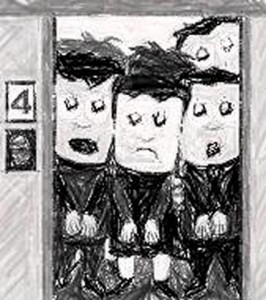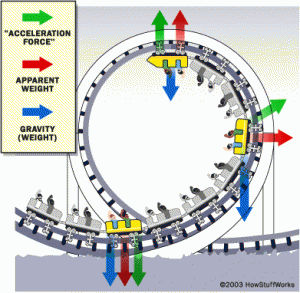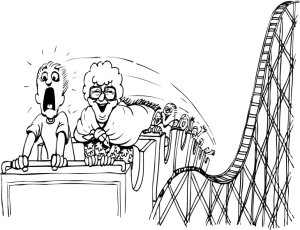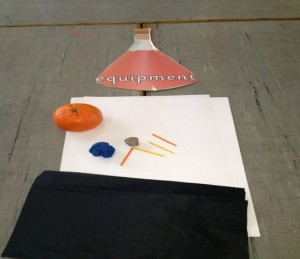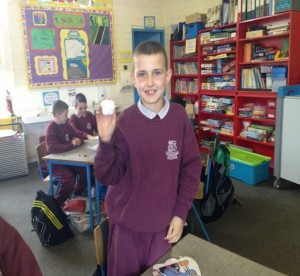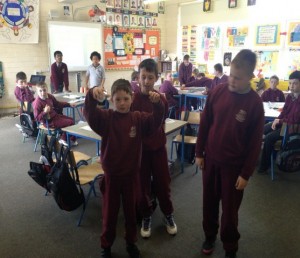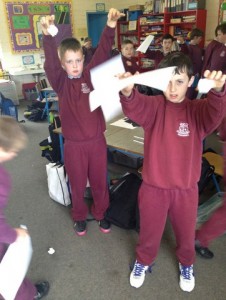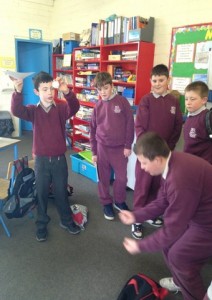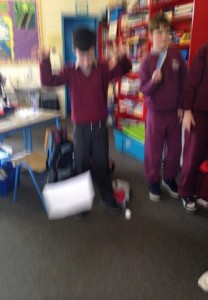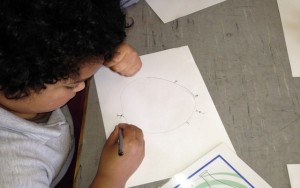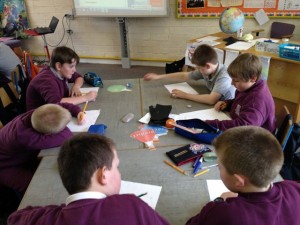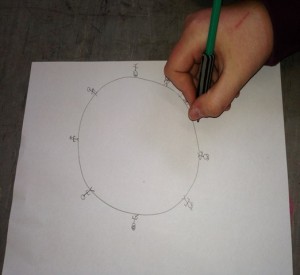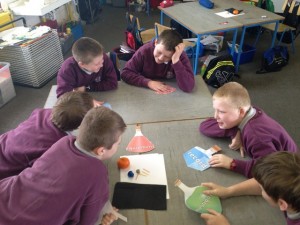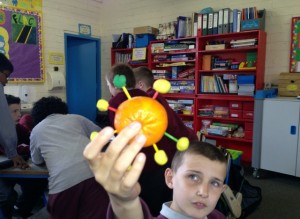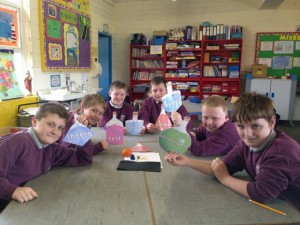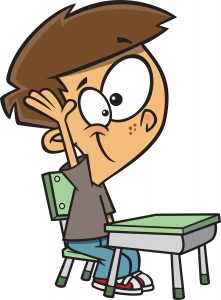
Fourth class looked at the Energy and Forces strand of the Science curriculum focusing on the topic of Gravity. We integrated this into other subjects such as Maths, Geography and History.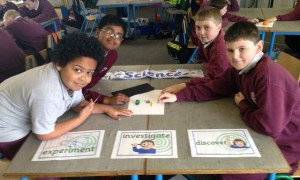
Task: To investigate Gravity
Alan and Johnny ask some ‘discovery’ questions.
Oisin and Andy think about the question posed: What is gravity?
We started by asking this question: What is gravity?
The boys were divided into four groups and gave the following answers:
Group 1: Gravity is a force that is in the center of the earth that pulls everything towards it.
Group 2: Gravity is something that is like a magnet under the ground that keeps us down.
Group 3: Gravity is the source of air that keeps us down on the ground.
Group 4: Gravity is something that is not in space and pulls everything towards it.
- The boys were then asked to think about an astronaut in space and asked the question: Is there gravity in space?
Fourteen answered no and 3 of them answered yes.
- We discovered that in fact there IS gravity in space. Otherwise the spacecraft’s would float away into the universe. We see pictures of astronauts floating because there is weightlessness inside the spaceship. This is called ‘freefall’ or ‘weightlessness.’ Johnny and Ameesh
The boys were asked to consider a number of trigger questions and gave the following responses:
- 1. When you let go of something what happens?
Group 1: It falls down to get as close to gravity as it can
Group 2: It falls down to the ground
Group 3: It drops downwards
Group 4: It will drop down and hit the ground
- 2. What makes it go in that direction?
All groups agreed it is the force of gravity.
- 3. What will happen to a stone when you drop it in Australia or New Zealand? Does it fall off into space?
Jack and Leon show Australia and New Zealand on the globe.
Thirteen of the boys agreed it would fall to the ground and four thought it would go up!
We learnt that gravity is everywhere and of course the stone would fall to the ground.
- 4. Have you ever been in a lift which suddenly went down very quickly? What did it feel like?
- Aaron – My legs felt weird when it moved so fast
- Ben – I started to get butterflies in my tummy like when you are going up a hill
- Leon – It felt a bit like turbulence, like your body is floating upwards while you are going down
- Andy –I felt like I was going to float up and touch the roof of the elevator
- Johnny- My tummy felt funny and I felt like I was flying in the elevator
- Oisin – I felt like I was floating.
- Ameesh – My tummy felt like it was getting really light.
- Adam – I felt very lightheaded
- Sam – My stomach felt like it was going to pop off
- Davy – It felt like my legs were made of jelly
5. Have you ever been on a rollercoaster or a Big Wheel that suddenly went down? Can you remember how you felt?
- Leon: I was on Space Mountain and it launches you down and I felt like I was being pushed downwards and backwards in my seat.
- Robert – l felt like there was rice crispies in my stomach jumping up and down!
- Ben – Once I turned my head I couldn’t turn it back because of the speed, my tummy felt dizzy.
- Johnny – My head went really light, like I hadn’t got a head and my stomach was going around in the air really fast.
- Oisin – It felt like my organs were hopping up and down inside my body.
- Jack – It felt like I had no legs and dizzy because they were going up in the air really fast.
- Davy –My stomach felt sick and my head and arms went dead heavy.
We discovered that sometimes the relative increase or decrease of gravitational pull caused by an elevator or a rollercoaster effects the displacement of the fluid of the inner ear. The result is temporary dizziness and can also make you feel sick. Some people are more sensitive than others. Leon and Sam
6. If you drop something big and something small which would hit the ground first?
If you drop something heavy and light which would hit the ground first?
The boys believed that the bigger thing would hit the ground first; they were not sure about the heavy or light things so we decided to investigate by doing an experiment.
Activity
Aim: To explore when dropping things of different weight which will hit the ground first.
Equipment: Sheets of paper and stones
Method:
- Take a piece of paper in one hand and a stone in the other.
- Which is heavier?
- Which will fall faster?
- Roll up a piece of paper into a tight ball.
- Drop the stone and the paper from the same height at the same time.
- Stand up on the table and drop them again from a higher height.
- Record the result.
- If this activity was done where there is no air for example in space or on the moon what would happen?
Result:
The stones fell slightly faster than the pieces of paper and hit the ground first. This is because of the air resistance surrounding the earth. The stone is heavier than the paper and so it hit the ground first. If there was no air then both items would reach the ground at exactly the same time.
We then repeated the above experiment but with two pieces of paper.
Aim: To explore if we drop two pieces of paper of the same weight but of different shapes which will hit the ground first? Will they both fall at the same speed?
Equipment: Sheets of paper
Method:
- Take two pieces of paper and roll one up into a ball like in the last experiment and leave the other one flat.
- Do you think they will fall at the same speed?
- The boys predicted that they would both land at the same time as they are both the same weight.
- Drop them from the same height at the same time. What happens this time?
- Drop them from different heights and see if the result changes.
- Record the results.
Result:
The paper rolled into the ball hit the ground first. This is because there was more air under the flat one, pressing up on it and slowing it down. This is called air resistance. We discussed that this is how a parachute works.
We also looked at dropping things on different parts of the Earth.
The children drew a large circle on a piece of paper, to represent the Earth. They then drew lots of people standing on different parts of the Earth.
We then worked on another activity to represent how people feel gravity in different parts of the world.
Equipment:
Paper, Pencils, Oranges, Cocktail sticks, plasticine
Method:
The boys made plasticine people using cocktail sticks and plasticine. They placed the ‘people’ onto the orange to represent how people feel gravity around the world.
Maths and Science
Strand: Measures, Operations
Strand Unit: Weight, Fractions
We decided to integrate our Science with Maths by calculating the weight of different items on the moon.
Method:
- We took some everyday items including a bag of sugar, an apple, a stone, book and a pencil.
- We estimated their weights on Earth
- Weighed them to get their actual weight
- Recorded their actual weights
- Knowing that on the moon gravity is about one-sixth of that on Earth we calculated weights by finding one-sixth of the actual weights
- Finally we recorded our results.
|
Object |
Estimated weight on Earth |
Actual weight on Earth |
Weight on the Moon |
| Sugar | 8 | 10 | 10/6 = 1.66 |
| Orange | 2 | 1.6 | 1.2/6 =0.2 |
| Stone | 7 | 4.8 | 4.8/6 = 0.8 |
| Book | 5.5 | 3.6 | 3.6/6 = 0.6 |
| Pencil | 1 | 0.48 | 0.48/6 = 0.08 |
Fourth class have thoroughly enjoyed the activities and learning as part of the Discovery Primary Science awards!

